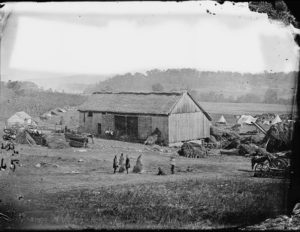The early settlers of Boonsboro and the surrounding areas faced the risk of injury and disease without the benefit of modern medicine. Robert Koch and Louis Pasteur first established the germ theory of disease in 1870, 82 years after the founding of Boonsboro. And physicians and caregivers did not recognize hand washing as a critical hygienic practice until the mid 1800’s. Thus, life expectancy in the early 1800’s was only 37 years, largely because of the staggeringly high infant mortality rates.
In addition to the threat of smallpox, cholera, typhoid fever, pneumonia and influenza, common accidents often led to debilitating and fatal injuries and infections. Folk medicine, family tales, Indian lore, and homegrown herbs were the available remedies usually administered by the chief medical person of the time, the housewife. Prior to 1806, Dr. Peter Fahrney served the Boonsboro community from his laboratory near Mapleville. He studied Native American herbal medicine and the curative properties of plant material collected in the area, becoming famous for his formulated patented medicines.
In 1806, Dr Meyer arrived in Boonsboro to practice medicine, followed by Dr. Ezra Slifer in 1809. Dr. Slifer is remembered for building Lilacs of Rose Hill, now part of Reeder’s Memorial Nursing Home. In 1833 Dr. Otho Josiah Smith began practice in Boonsboro, later acquiring a large farm two miles northeast of Sharpsburg bordering on Antietam Creek. The barn on this property was used as a hospital for Union wounded and tents nearby housed numerous fallen Confederates. It is believed that Confederate surgeon, Dr. John M. Gaines, labored alongside Dr. Smith in that makeshift hospital and the two became friends. And it appears that Gaines had taken careful note of Dr. Smith’s lovely daughter. After the war he returned to Boonsboro, married Helen Jeannette Smith and went into practice with his father-in-law, Dr. Smith. Dr. Gaines practiced medicine in Boonsboro for 28 years living in the stone house at 28 North Main Street.
Photo of Dr. Smith’s barn and surrounding property near Sharpsburg; courtesy Library of Congress.



